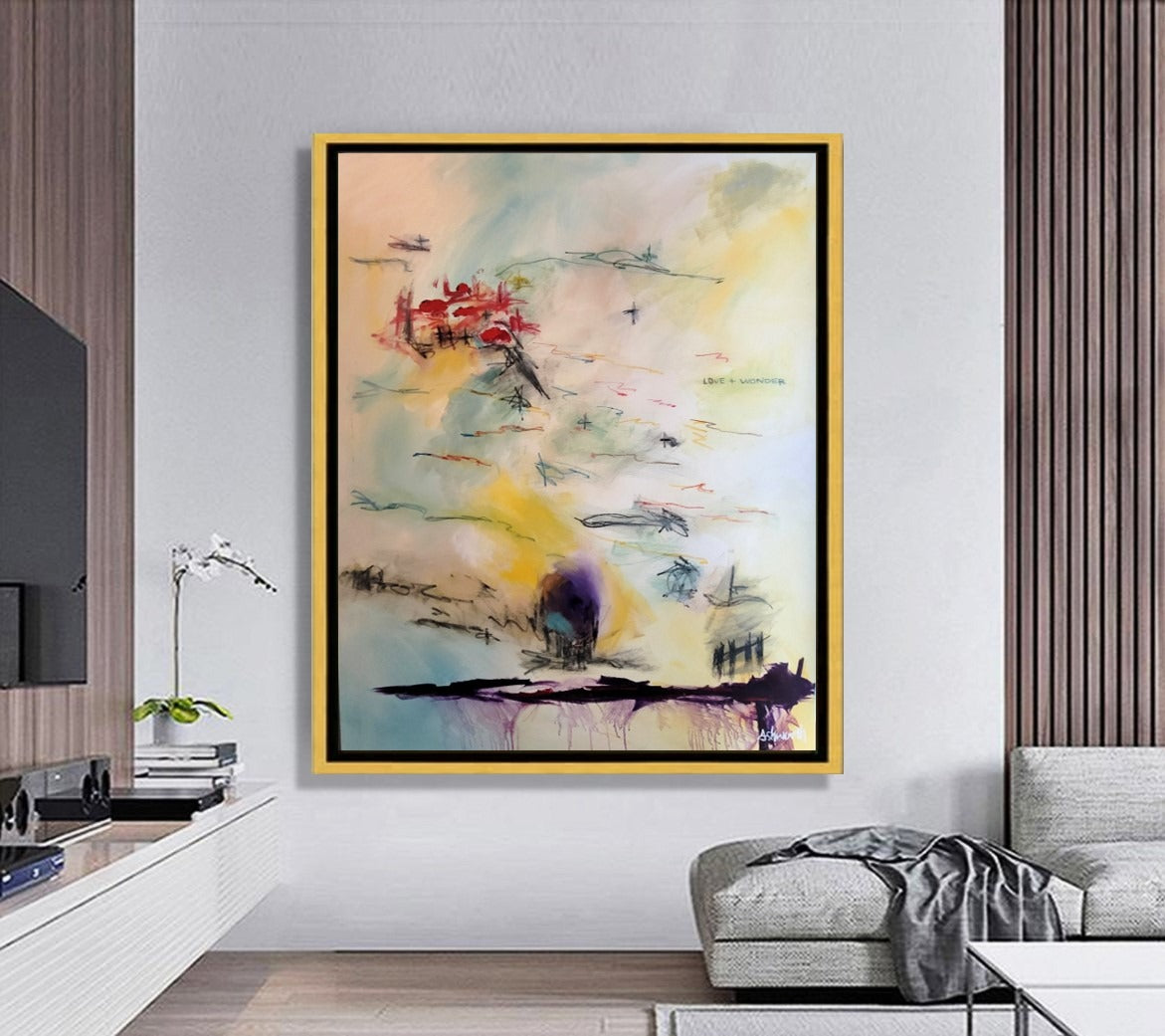
Why Art Is Uniquely Personal to You (or, Why Art That Moves You … May Not Move Others).

Art has been a cornerstone of human civilization since time immemorial, reflecting cultural shifts, technological advancements, and highly personalized emotional and creative expressions. Whether it's abstract art, pop art, contemporary art, or portrait art, each piece holds a unique significance to different individuals.

But why is art so profoundly personal? And why do you connect with some artworks that others might overlook? Let's explore the intimate relationship between art, personal preference, and your life’s personal experiences.
The Power of Subjectivity in Art
One of the most fascinating aspects of art is its subjectivity. Unlike science or mathematics, where answers are definitive, art thrives in ambiguity. A single painting, sculpture, or song can elicit an infinite range of interpretations. This subjectivity arises because each person brings their own experiences, emotions, and cultural context to their interaction with art.
For instance, a contemporary art piece might evoke feelings of nostalgia for one viewer while inspiring a sense of adventure in another. This divergence occurs because art serves as a mirror, reflecting not just the artist’s intention but also the viewer’s inner world. It’s this duality—a dialogue between creator and observer—that makes art so profoundly personal.
Life Experiences Shape Artistic Preferences
Your unique life experiences play a significant role in shaping your preferences for certain types of art. Here's how:
1. Life Experiences: A painting of a bustling city might resonate with you if you grew up in an urban environment but feel overwhelming to someone who prefers tranquil rural settings.
2. Emotional States: Feeling joyful might draw you to vibrant and colorful art, while experiencing grief may make you gravitate toward somber or introspective pieces.
3. Artistic Style: You might love abstract paintings, finding depth in their complexity, while others see them as chaotic and lacking meaning.
4. Cultural Context: Symbols and themes in art might carry profound meaning for you due to your cultural background but seem inaccessible or abstract to others.
5. Exposure to Styles: If you're accustomed to avant-garde or contemporary art, you might appreciate experimental pieces, while those exposed primarily to classical traditions may prefer works rooted in realism or historical forms.
These differences in perception reflect the deeply personal nature of art and the way it connects to individual identities and experiences.

Art as a Vessel for Emotions
Art often becomes a container for emotions too complex or abstract to express verbally. Whether it’s a heart-wrenching ballad, an evocative photograph, or an abstract painting, art provides a safe space to explore feelings. For the artist, creating is an act of emotional release, a way to channel joy, sorrow, anger, or love. For you as the viewer, engaging with art can elicit these same emotions, creating a shared, albeit individualized, experience.
Consider the universal appeal of music. A song that speaks to heartbreak can resonate across cultures and languages, touching listeners who may have experienced entirely different forms of loss. Similarly, visual art often communicates feelings through subject matter, color, texture, and composition, bypassing the need for words entirely. This emotional resonance is why art feels deeply personal—it validates and amplifies emotions, making the intangible tangible.
The Personal Touch of Creation
For artists, the act of creation is inherently personal. Each brushstroke, melody, or chisel mark carries their unique perspective, experiences, and intentions. Even when artists draw inspiration from external sources, their interpretation is shaped by their individuality.
This personal imprint is why no two works of art are the same, even when they depict the same subject. Two painters capturing the same sunset will inevitably produce different results because their techniques, emotional states, and artistic visions vary. This singularity in creation ensures that art is always a deeply personal expression.

Cultural and Personal Context
Art doesn’t exist in a vacuum. It is shaped by the cultural and personal context of both its creator and its audience. Your cultural background, upbringing, and personal history influence how you interpret and connect with art. This interplay between culture and individuality adds another layer to art’s personal nature.
For example, a traditional Japanese ink painting might resonate deeply with someone who has grown up appreciating the subtlety and philosophy of wabi-sabi, the Japanese aesthetic of imperfection and impermanence. Meanwhile, someone unfamiliar with this cultural context might admire the piece for its visual beauty but miss the deeper meanings. In both cases, the experience remains personal—shaped by individual perspectives.
Memory and Association
Art has the unique ability to evoke memories and associations. A particular color palette might remind you of your childhood home, while a melody might transport you back to your first dance. These connections are often subconscious, rooted in personal experiences that shape how you perceive and respond to art.
This phenomenon explains why art can feel so personal even when the subject matter seems unrelated to your life. A painting of a serene forest might resonate with you if you grew up near the woods, invoking a sense of peace and familiarity. Meanwhile, the same painting might feel melancholic to someone who associates forests with solitude or loss. These personal associations transform art into a deeply individualized experience.
Art as a Tool for Self-Discovery
Engaging with art can also be a journey of self-discovery. Whether creating or observing, art encourages introspection, prompting you to explore your thoughts, emotions, and identity. This process can be cathartic, offering insights into yourself that might otherwise remain hidden.
For creators, the act of making art often reveals subconscious desires, fears, and dreams. It’s not uncommon for artists to describe their work as an extension of themselves, a visual or auditory manifestation of their inner worlds. For you as a viewer, engaging with art can provoke questions and realizations, acting as a catalyst for personal growth.
The Universality of Art’s Personal Impact
Despite its deeply personal nature, art also has a universal quality. Great art resonates across time and cultures because it taps into fundamental human experiences: love, loss, joy, fear, and hope. These shared themes create a bridge between the personal and the collective, demonstrating that while your responses to art are individual, they are also part of a larger human story.
Take Vincent van Gogh’s "The Starry Night", for example. Its swirling sky and vibrant colors evoke a sense of wonder and introspection that transcends cultural boundaries. While each viewer may interpret the painting differently, the emotions it stirs are universally relatable. This duality—personal and universal—is what makes art so powerful.

Why Art Matters in a Digital Age
In today’s fast-paced, technology-driven world, the personal connection art provides is more valuable than ever. Amid the constant noise of social media and digital distractions, art offers a moment of pause, a chance to reconnect with yourself. Whether it’s a digital illustration shared online or a centuries-old painting in a museum, art bridges the gap between the external and internal, grounding us in our humanity.
Moreover, technology has democratized access to art, allowing more people to create and engage with it. From digital painting apps to virtual museum tours, art is now more accessible than ever. This increased accessibility has amplified art’s personal impact, enabling individuals to explore and share their creative expressions with the world. If you're looking to buy art or find art for sale, the digital age has opened up countless avenues to discover pieces that resonate with you.
Conclusion: The Unique Bond Between Art and Individuality
Art is uniquely personal because it reflects the infinite diversity of human experience. It is a language of emotions, memories, and perspectives, allowing creators and observers to connect with themselves and others on a profound level. Art invites you to see the world through different lenses, enriching your understanding of yourself and your place in the world.
In a world that often prioritizes efficiency and logic, art reminds us of the beauty and complexity of being human. It is both deeply individual and universally relatable, a testament to the power of creativity and the enduring importance of personal expression. So the next time you encounter a piece of great art that moves you—be it abstract art, pop art, or any other form—take a moment to reflect on why it resonates and savor the uniquely personal journey it inspires.
Whether you're an avid collector or new to the art scene, exploring and purchasing art that speaks to you can be a fulfilling experience. Remember, the art you choose reflects your individuality and personal journey. If you're interested in adding unique pieces to your collection, there's a world of art for sale waiting to be discovered.
- Peter Ashworth.

Peter Ashworth is a Southern California impact artist whose purpose is to inspire people to feel alive, take them on a journey of transformation, and help them live their best creative life.
He believes his art should engage, entertain and uplift his customers to express their creative nature, to spark their imagination, and their desire to live creatively. He has an attraction to iconic life moments, whimsy and pop culture, and has a keen eye for color, progressive design, and subject matter honed over 30 years as a branding and marketing expert.
His art is created to be a centerpiece, an experience, to mentally engage the viewer.
He works across six different subject areas, each with a unique purpose of creating life-moment reactions and mental engagement with his viewers in the habitats and environments where his art is located.
He is a working artist available for personally commissioned art.
peterashworth.art #peterashworthart #creativelife

